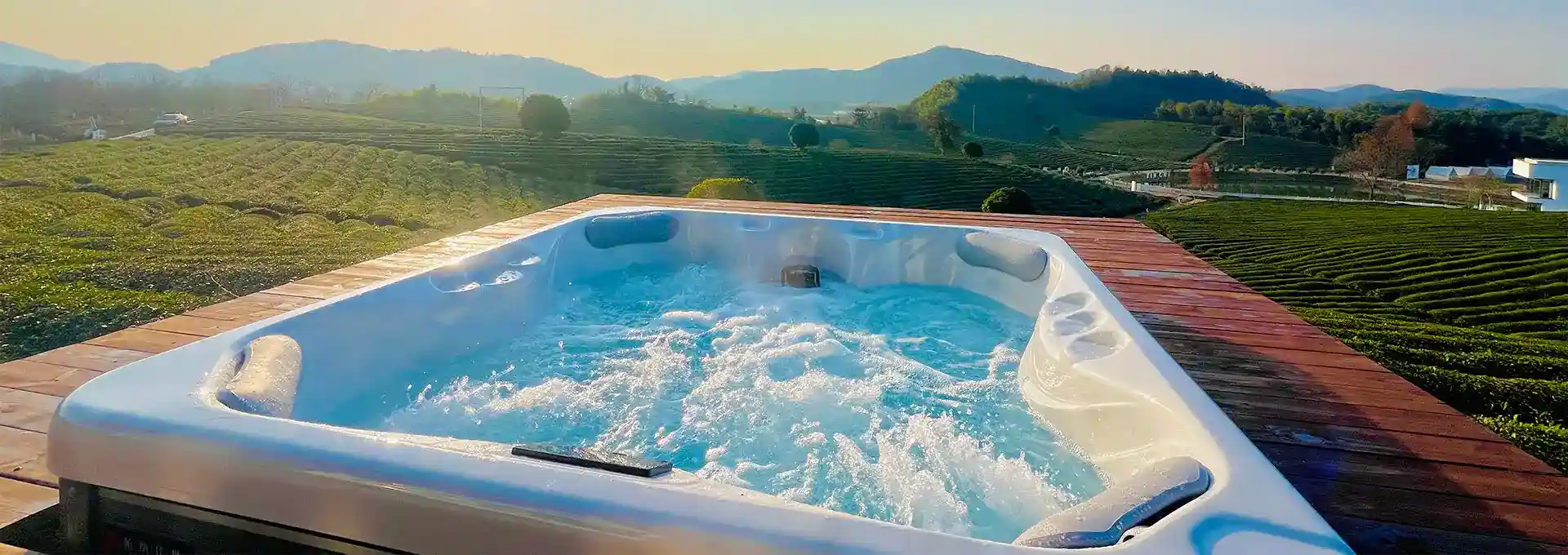Can a Swim Spa Go Inground?
2024-10-14 09:41:37
Swim spas have gained popularity in recent years as a versatile alternative to traditional swimming pools. These compact units offer the benefits of both a swimming pool and a hot tub, allowing users to enjoy aquatic exercise and relaxation in a single space. One question that often arises when considering a swim spa installation is whether it can be installed inground. The short answer is yes, a swim spa can indeed be installed inground, offering a sleek and integrated look to your backyard oasis. In this blog post, we'll explore the ins and outs of inground swim spa installations, addressing common questions and providing insights to help you make an informed decision.
How Much Does it Cost to Install an Inground Swim Spa?
When considering an inground swim spa installation, one of the first questions that comes to mind is the cost. The price of installing an inground swim spa can vary significantly depending on several factors, including the size and model of the swim spa, the complexity of the installation, and your location. On average, you can expect to pay anywhere from $30,000 to $70,000 for a complete inground swim spa installation.
The cost breakdown typically includes the following components:
1. Swim spa unit: The swim spa itself can range from $20,000 to $50,000, depending on the size, features, and brand.
2. Excavation and site preparation: This involves digging the hole for the swim spa, which can cost between $3,000 and $8,000, depending on the soil conditions and accessibility of your property.
3. Structural support: A concrete vault or reinforced walls may be necessary to support the swim spa, which can add $5,000 to $10,000 to the total cost.
4. Electrical and plumbing work: Professional installation of electrical and plumbing systems is crucial for safety and functionality, typically costing $2,000 to $5,000.
5. Decking and landscaping: Finishing touches such as decking around the swim spa and landscaping can range from $3,000 to $10,000 or more, depending on the materials and design complexity.
While the initial investment may seem substantial, it's important to consider the long-term benefits of an inground swim spa. Compared to a traditional inground swimming pool, a swim spa often has lower ongoing maintenance costs and energy consumption. Additionally, the versatility of a swim spa – offering both exercise and relaxation options – can provide excellent value for your investment.
To potentially reduce costs, consider the following tips:
1. Choose a smaller swim spa model if it meets your needs.
2. Opt for a simpler installation design without extensive custom features.
3. Consider doing some of the prep work yourself, such as clearing the installation area.
4. Get multiple quotes from reputable installers to ensure competitive pricing.
5. Look for off-season discounts or package deals that may include installation services.
Remember that while it's tempting to cut corners to save money, investing in quality installation and materials will pay off in the long run through improved durability, functionality, and enjoyment of your inground swim spa.
What Are the Benefits of an Inground Swim Spa?
Inground swim spas offer numerous benefits that make them an attractive option for homeowners looking to enhance their outdoor living space and improve their health and wellness routines. Let's explore some of the key advantages of installing an inground swim spa:
1. Aesthetic appeal: One of the most significant benefits of an inground swim spa is its seamless integration with your landscape. Unlike above-ground models, inground swim spas create a sleek, custom look that enhances the overall appearance of your backyard. They can be surrounded by decking, stone work, or landscaping to create a cohesive and visually appealing outdoor living area.
2. Space efficiency: Inground swim spas are an excellent solution for homeowners with limited space. They offer the benefits of both a pool and a spa in a compact footprint, making them ideal for urban settings or smaller yards where a full-sized pool might not be feasible.
3. Year-round use: Unlike traditional pools, which are often seasonal in many climates, inground swim spas can be used throughout the year. Their advanced heating systems and insulation allow for comfortable use even in colder months, extending your swimming and relaxation season.
4. Versatility: Inground swim spas are incredibly versatile, catering to a wide range of activities and preferences. They can be used for:
- Low-impact aquatic exercise and swimming against an adjustable current
- Hydrotherapy and relaxation with built-in jets and seating
- Family fun and entertainment
- Rehabilitation and physical therapy
5. Energy efficiency: Compared to traditional pools, inground swim spas are generally more energy-efficient. Their smaller water volume requires less energy to heat and maintain, potentially resulting in lower utility bills.
6. Customization options: Inground installations offer greater flexibility for customization. You can incorporate features like built-in lighting, water features, or even integrate the swim spa with an existing pool or outdoor living area.
7. Increased property value: A well-designed and properly installed inground swim spa can add value to your property. It's seen as a luxurious amenity that can make your home more attractive to potential buyers if you ever decide to sell.
8. Low maintenance: Inground swim spas typically require less maintenance than traditional pools due to their smaller size and advanced filtration systems. This means you can spend more time enjoying your spa and less time on upkeep.
While the initial investment for an inground swim spa may be higher than an above-ground model, the long-term benefits often outweigh the costs. The combination of aesthetic appeal, functionality, and potential for increased property value makes inground swim spas an attractive option for many homeowners seeking to create a luxurious and practical outdoor living space.
How Deep is an Inground Swim Spa?
When considering an inground swim spa, one of the key factors to understand is its depth. The depth of an inground swim spa plays a crucial role in its functionality, safety, and overall user experience. Unlike traditional swimming pools, which often have varying depths, swim spas typically maintain a consistent depth throughout. Let's explore the standard depths of inground swim spas and the factors that influence depth selection.
Standard Depths:
Inground swim spas generally range from 48 inches (122 cm) to 60 inches (152 cm) in depth. This range is designed to accommodate a variety of users and activities while maintaining safety and functionality. The most common depths you'll encounter are:
1. 48 inches (122 cm): This depth is ideal for many users, providing enough water for effective swimming and exercise while still allowing most adults to stand comfortably.
2. 51 inches (130 cm): A slight increase in depth that offers a bit more buoyancy for swimming without significantly affecting the ability to stand.
3. 54 inches (137 cm): This depth provides a good balance between swimming depth and safety, suitable for taller individuals or those seeking a more immersive experience.
4. 60 inches (152 cm): The deepest standard option, typically found in larger swim spa models. This depth is excellent for swimming and water exercises but may be too deep for shorter individuals to stand comfortably.
Factors Influencing Depth Selection:
1. User height and preferences: The ideal depth often depends on the height of the primary users. Taller individuals may prefer deeper swim spas, while shorter users or families with children might opt for shallower models.
2. Intended use: If the primary purpose is for swimming and exercise, a deeper spa might be preferable. For relaxation and hydrotherapy, a shallower depth could be more suitable.
3. Safety considerations: It's important to choose a depth that allows users to safely enter and exit the swim spa. For families with children or elderly users, a shallower depth may be more appropriate.
4. Local regulations: Some areas have specific depth requirements for inground installations. Always check local building codes and regulations before deciding on a depth.
5. Installation considerations: The depth of your swim spa may be influenced by factors such as the water table in your area, soil conditions, and the presence of underground utilities.
6. Energy efficiency: Deeper swim spas require more water, which can increase heating costs. If energy efficiency is a primary concern, a shallower model might be more suitable.
Custom Depth Options:
While most manufacturers offer standard depth options, some may provide custom depth solutions for inground installations. This can be particularly useful if you have specific requirements or want to match the swim spa depth to an existing pool or landscape design. However, custom depths may increase the overall cost of the project and potentially affect warranty coverage.
Depth vs. Water Volume:
It's important to note that the depth of a swim spa doesn't necessarily correlate directly with its water volume. The length and width of the spa also play significant roles. A longer, wider swim spa with a shallower depth may still hold more water than a shorter, narrower model with greater depth.
Safety Features Related to Depth:
Regardless of the chosen depth, inground swim spas often come with safety features to ensure user well-being:
1. Non-slip surfaces on the spa floor and steps
2. Handrails or grab bars for easy entry and exit
3. Clear depth markings
4. Automatic safety covers to prevent accidental entry when not in use
Depth and Current Strength:
The depth of a swim spa can affect the strength and feel of the swimming current. In general, deeper swim spas may provide a more natural swimming experience, as the current has more space to develop before reaching the swimmer. However, advanced propulsion systems in modern swim spas can create effective currents even in shallower models.
Conclusion
Choosing the right depth for your inground swim spa is a balance between personal preferences, safety considerations, and intended use. While standard depths range from 48 to 60 inches, the best choice depends on your specific needs and circumstances. Consulting with a professional swim spa installer can help you determine the optimal depth for your inground installation, ensuring that you get the most enjoyment and value from your investment.
Remember, regardless of the depth you choose, proper installation and adherence to safety guidelines are crucial for creating a safe and enjoyable swim spa experience. Always follow manufacturer recommendations and local regulations when installing and using your inground swim spa.
For more information on hot tub installations and to find out more about our products, please feel free to contact us at info@iparnassus.com.
References
1. Swim University. (2023). "Can You Put a Swim Spa In-Ground?"
2. Hydropool. (2024). "Can You Put a Swim Spa In Ground?"
3. Swim Spas Plus. (2023). "Inground Swim Spas: Everything You Need to Know."
4. Master Spas. (2024). "Can a Swim Spa Be Installed In-Ground?"
5. Aqua Magazine. (2022). "The Ins and Outs of In-Ground Swim Spas."
6. Endless Pools. (2024). "In-Ground vs. Above-Ground Swim Spas."
7. SwimEx. (2023). "Inground Swim Spa Installation Guide."
8. PDC Spas. (2024). "Inground Swim Spa Installation Options."
9. Backyard Leisure. (2023). "The Costs of Installing an Inground Swim Spa."
10. Home Stratosphere. (2024). "Pros and Cons of Inground Swim Spas."



